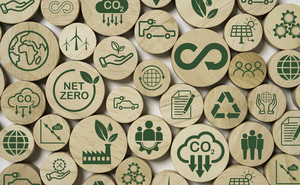

|
Edward Lowton
Editor |


|
| Home> | Energy Management | >Sustainable energy | >Defining sustainability in manufacturing |
Defining sustainability in manufacturing
11 June 2025
Over 75% of the global top 50 machine builders are actively promoting ways in which their machines enable greater sustainability for manufacturers - from energy efficiency to retrofitting, explains Stefania Moruzzi

THERE IS no question that manufacturers are investing more in sustainable practices - right across the globe.
The urgency to invest in sustainable manufacturing is driven by both financial benefits and competitive positioning. Early adopters simply start gaining the financial advantages and savings more quickly - lower cost of energy, raw materials, water, consumables, catalysts, lubricants, etc.
In addition, manufacturers can gain a competitive advantage by embedding sustainability while the market is still developing. For early adopters, sustainable claims are a stand-out factor which can beat the competition to a sale or contract. After all, an increasing number of invitations-to-tender from manufacturers now include sustainability requirements.
Sustainability-enabling technology almost always involves digital transformation. The market for digitally-enabled, more sustainable manufacturing has a ‘tipping’ point when around half of manufacturers will have invested ‘significantly’ in digital transformation. Research predicts this ‘tipping point’ to be around 2026 for larger manufacturers, and 2030 for smaller to medium-sized companies . Those who invest in the first half of the cycle should gain competitive advantage. Those who wait until the second half will simply be playing catch-up.
Currently, 25-30% of global manufacturers of all sizes have made ‘significant’ adoption of digital technologies - the essential technological basis for sustainable manufacturing. All this tells us that investing in sustainability-enabling technology still has plenty of potential for competitive advantage, but the clock is ticking.
Which technologies are the focus for sustainable transformation?
To provide current insights on sustainability priorities, a new study by Siemens Financial Services analysed the sustainability -enabling features of manufacturing equipment and machines, as promoted by the world’s top 50 production machine builders.
The most universal sustainability gain focuses on decarbonisation and resource efficiency, specifically energy efficiency, applicable to most production machines. Almost as popular as energy efficiency are the benefits of digitalisation, in the form of productivity gains through Industry 4.0 that enables manufacturers to do more with the same/less.
Circularity is also clearly a major issue for most machine builders, over half of whom are offering retrofit and refurbishment options to their manufacturing clients in order to save natural resources in machine construction (carbon savings that then can be passed on to the manufacturing client’s Scope 3 measurement).
Additionally, many machine builders are remanufacturing worn parts, sometimes using additive manufacturing or 3D printing, while digital twin technology enables rapid development of new, more sustainable machines.
Water efficiency and the use of alternative or recycled raw materials are only relevant to certain production machine technologies. The key clusters for these sustainability - enabling capabilities are food and beverage processing machines (where water is a key raw material) and semiconductor making machines (which use a great deal of water for cooling).
Barriers to sustainability investment
Although manufacturers recognise the need to invest in sustainability, and machine builders are developing more sustainable equipment, investment challenges persist. Globally, economic and manufacturing outlook is quiet, despite the occasional positive uplift. Inflation has pushed up input prices for manufacturing, putting further pressure on manufacturing margins. In this environment, most companies prioritise having cash available, so they can act nimbly in response to changing or developing market opportunities.
Third-party financing is crucial for advancing sustainability in manufacturing. Financing tools help machinery and equipment vendors sell their more sustainable solutions by making it easy for the manufacturer to invest through monthly payments, with no need to find (and tie up) substantial amounts of scarce capital. Usually available from specialist financiers who have a deep understanding of the underlying technology and its commercial and sustainability enabling benefits in the field.
Key financing categories include:
- Integrated Finance: Spreads costs over several years, aligning payments with cash flow, while vendors are paid immediately. It operates separately from existing bank credit lines and covers total ownership costs through subscription models.
- Flexible Structures: Financing specialists adjust terms to make options affordable, offering low-start or deferred payments aligned with operational benefits. Emerging models include managed services and 'as-a-service' options tied to outcomes like uptime or output.
- Retrofit Finance: Covers the modernisation of existing machinery, reducing costs and carbon footprints. It requires financiers with expertise in retrofitting to structure deals and assess risks effectively.
- Pay Later: Benefits machine builders by allowing them to delay payment for components for up to six months, aligning with machine order and delivery timelines to better manage cash flow.
Prioritising sustainability in machine building
By examining the degree to which each of these areas of sustainability gain are being featured and promoted by machine builders around the world, a clear priority order emerges. Energy efficiency and productivity gains from digitalization are the most widely applicable across industry sectors, whereas areas such as water efficiency or recycled raw materials are not always so widely relevant.
It is clear from this research that almost all production machine builders are emphasiSing some form of sustainability enablement for their machines. Yet challenging economic circumstances mean pressure to transform to more sustainable manufacturing can only be optimized and accelerated when technology is combined with specialist financing tools that make the conversion affordable and cash-flow friendly.
Stefania Moruzzi is business development manager at Siemens Financial Services UK
For more information:


















